
(THEIR SURVIVAL IS IN OUR HANDS)

BY DR. RAVINDER PALL SAINI,
INDIAN FOREST SERVICE (RETIRED)
MEMBER, BOARD OF MANAGEMENT,
FOREST RESEARCH UNIVERSITY
DEHRADUN.
DEHRADUN, 29 JULY 2023:

Tiger Is An Emblem of Beauty, Valour, Vigour, and Nationality So Save The Tiger To Save The National Pride.
International Tiger Day 2023 will be celebrated without any specific theme with the common goal to raise awareness about tiger extinction and the need to save them.
Ecological Value:
Tiger – The Magnificent Royal, Regal, Majestic and Courageous Wild Species.
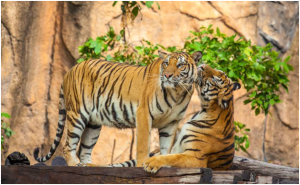
Tigers are an integral component of our planet’s natural heritage; they also have a great enlightening and historic significance. No doubt they are also key for the ecosystems in which they reside. We cannot dispense with that tiger not only protect the forest by maintaining ecological integrity but also, they bring highest levels of protection and investment to an area. Therefore, it is recognized as “umbrella species”, that is their conservation also conserve many other species in the same protected area.

Reasons behind the declining population of Tigers World over are:
i) Poaching and illegal trade: For traditional Chinese medicines, tigers face problem of poaching as there is a demand of every part of the body of tiger. In the illegal wildlife trades, they keep high prices.
ii) Habitat loss: Nowadays and with the increasing population forests are becoming less in numbers. Clearing of forests for several reasons like agriculture, industries, etc. made loss of around 93% of the natural habitats of tigers.
iii) Climate Change: The rise of sea level due to climate change led to wiping out of Sundarbans, one of the habitats of Royal Bengal Tigers.
iv) Several diseases: These are also the key factors. Several animals die and there is no way to ascertain the cause of their death. Certain diseases spread epidemic like Feline Panleucopania, tuberculosis etc.
v) Loss of Genetic diversity: The study of Wildlife Institute of India (WII) in Ranthambore Tiger Reserve (RTR) says that tiger population in the park shown a loss of genetic diversity over the years.
vi) Degradation of Habitats: Big cats want secure and disturbance free habitat to survive but due to several developmental activities in the landscape of the protected areas (PAs) pose a big threat to tigers.
vii) Man-animal conflict: This also affects the population of big cats like many other wildlife species.
viii) Protection: Lack of well-built protection infrastructure to safeguard the conservation efforts and habitat in large scale affects the survival of tigers.
ix) Growing Tourism: Increasing demand for tourism day by day is also one of the factors for the decline in tiger numbers as it causes immense disturbance to the habitat in general.
x) Financial Crunch: Lack of funds for building up infrastructure and development and maintenance of their habitats the conservation of tiger is also one of the main reasons.

CHRONOLOGY OF INTERNATIONAL TIGER DAY:
International Tiger Day got its inception in 2010 at the Saint Petersburg Tiger Summit in Russia with an objective to promote a worldwide system for protecting the natural habitats of tigers and to increase public awareness and support for tiger conservation issues after it was noticed that there is a sharp decline of all wild tigers and more than 95% had disappeared in the last century itself, with about only 3,000 of them remaining.
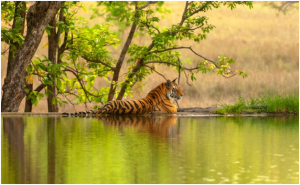
2017: The seventh annual Global Tiger Day was commemorated in diverse ways around the world. Local events were organized in Bangladesh, Nepal, and India as well as non-tiger-range countries such as England and the United States. Some celebrities also participated by removing their social media profile photos. The World Wildlife Fund (WWF) continued its promotion of the "Double Tigers" campaign through investing in rangers. Several companies partnered with WWF to help raise awareness.
2018: Additional efforts for generation of awareness in the entire world of tiger populations and the challenges for their conservationists were made. India counts the number of wild tigers every four years and showed a promising rise from 1411 in 2006 to 2226 in 2014. The trend for rising population of tigers in India is as follows:
In the year 2006 – 1411
In the year 2010 – 1706
In the year 2014 – 2226
In the year 2019 – 2967
In the year 2023 – 3167
In April 2023, the Prime Minister expressed happiness that India is home to 75% of the world’s tiger population in the 75th year of Indian independence. It is also a coincidence, the Prime Minister continued, that the tiger reserves in India cover 75,000 square kilometers of land and in the past ten to twelve years, the tiger population in the country has increased by 75 percent.
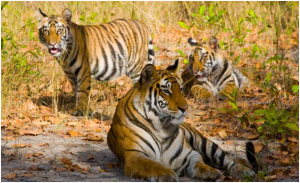
Tigers Habit:
Tigers generally gain independence at around two years of age and attain sexual maturity at age three or four for females and four or five years for males. Juvenile mortality is high, however—about half of all cubs do not survive more than two years. Tigers have been known to reach up to 20 years of age in the wild.
Tigers are mostly solitary, apart from associations between mother and offspring. Individual tigers have a large territory, and their size is determined mostly by the availability of prey. Individuals mark their domain with urine, faeces, rakes, scrapes, and vocalizing.
Adult male Royal Bengal tigers (Panthera tigris tigris) weigh about 220 kg and measure about 2.9 m. Females are slightly smaller with an average weight of 140 kg and 2.5 m in length.
Across their range, tigers face unrelenting pressures from poaching, retaliatory killings, and habitat loss. They are forced to compete for space with dense and often growing human populations.

IUCN New Subspecies Classifications:
Since 2017, IUCN has recognized two tiger subspecies, commonly referred to as the continental tiger and the Sunda Island tiger. All remaining island tigers are found only in Sumatra, with tigers in Java and Bali now extinct. These are popularly known as Sumatran tigers. The continental tigers currently include the Bengal, Malayan, Indochinese, and Amur (Siberian) tiger populations, while the Caspian tiger is extinct in the wild. The South China tiger is believed to be functionally extinct.
Key strategies To Conserve Tigers:
a) To ensure a world with healthy populations of wild tigers, we strive to stop the killing and trafficking of tigers.
b) Protect tigers and their habitat.
c) Build capacity in range states.
d) Reduce human-tiger conflict.
e) Conduct scientific research on tigers to help inform conservation strategies.
f) Promote tiger-friendly policies.
g) Monitor tiger numbers, population trends, and threats to tigers and their habitats.
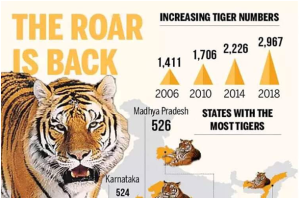
THE ROAR IS LOUDER IN INDIA:
Now 2022 figure stands at 3167. Report released by Prime Minister of India, Narendra Modi recently at Mysore.
Protecting Tiger is in Indian Culture and Ethos. Success of Project Tiger is our coexistence balance of Economy and Ecology.
In the 75th year of Independence we proudly hold 75% of world's Tiger population occupying 75000 square kilometers of prime forest area.

India now has 54 Tiger Reserves. The Guru Ghasidas National Park and the Tamor Pingla Wildlife Sanctuary are the newest Tiger Reserve of India in 2023. This is the 54th Tiger Reserve in India and is in Chhattisgarh.
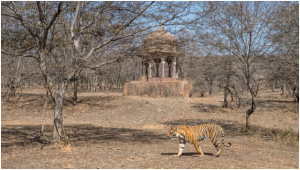
(GOD SAVE THE TIGER BY GRANTING SANITY TO MANKIND)

Advertisement:





























Add Comment